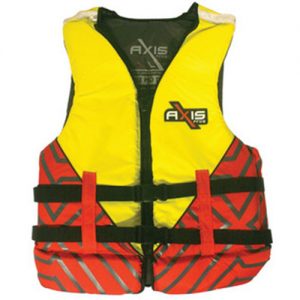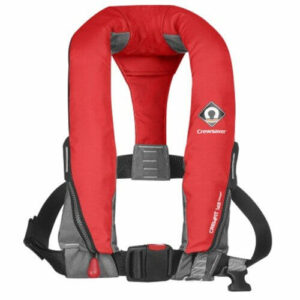How to Choose a Life Jacket in 5 Easy Steps
According to statistics, for 90% of the boating deaths in Australia, the victim was not wearing a PFD. A quality life jacket can save your life if you go overboard, even if you’re unconscious.
So how do you get the best life jacket for your boating needs? How do you pick from a bewildering array of choices to get something right for you?
Three key factors to consider when you shop:
- What type of boating do you do, and with who?
- Which life jackets are comfortable and meet the required buoyancy?
- What does the law require for your boating?
Types of Personal Flotation Devices
Choose a personal flotation device (PFD) which is comfortable for your water activities, and the legal requirements for your state and the type of waters you operate in. If you browse a boating website like this one, you’ll see personal flotation broken down by style and type of vest, as well as buoyancy.
Styles
There’s a wide variety in construction materials, design, and deployment methods for personal floatation but there are two basic types of flotation – foam and inflatable.
Foam/Filled
Foam pads or blocks sewn into a jacket or a collar style device for around the neck provide the buoyancy. These are low maintenance and simple to use. The collar style life jacket can be cumbersome and uncomfortable to move in, and can prove less popular if wearing all the time.
Foam life jackets and vests have less weight because of their construction, but the foam can be bulky and hamper movement. They also can be lower in price depending on the brand and style and have next to no ongoing service costs. Watersports where you’re always in the water, like Jetskiing, waterskiing and wakeboarding often use a combination of Neoprene and Foam construction to help with holding the jacket inplace during a fall and to lengthen the longevity of the jacket as it is constantly in and out of the water.
Inspect foam flotation annually to make sure there are no broken straps, buckles, or connectors, and no worn or weakened cloth or stitching.
Inflatable
Inflatable vests rely on an internal air bladder for buoyancy. The bladder fills with a CO2 from a cyclinger when activated, or may be blown up by the wearer with a tube. Inflatable jackets often are made with different activation methods, Manual pull cord, Automatic inflation which will inflate automatically when meet with water or hydrostatic release which will inflate the jacket only once the user is fully submerged all but eliminating a accidental automatic activation.
For the full time wear, inflatables are compact and light weight. Sailors prefer inflatable jackets with integral harnesses for safety and reduce bulk, and outerwear with inflatable floatation built in is a comfortable option. They’re also comfortable for fishing. Most inflatable vests have room for accessories like man overboard beacons and lights, and should have a whistle installed to help with rescue.
Inflatable PFD require maintenance which includes a periodic service in which the manufacturer will state the frequency of time after purchase that this should be done. Depending on the brand the manufacturer may state you can service the jacket yourself or it may be required to be taken to an authorised service agent.
Ratings and Buoyancy
Australian safety rules categorise personal flotation devices into four categories. You’ll find this rating on a label sewed to every life jacket.
- Level 275+ – the most buoyant, 275+ vests are used offshore and provide added flotation for bulky clothing and gear.
- Level 150 (Previously Type 1) – very buoyant, and are designed to turn the wearer face up if unconscious. This includes almost all inflatable vests. Level 150 is good for boating in all waters, including offshore, but not for Personal Watercraft (PWC).
- Level 100 (Previously Type 1) – less buoyant than 150, and mainly a foam construction the 100 also has neck flotation to ensure face up floating. This is the minimum floatation for semi and unprotected waters, and is also prohibited on a PWC depending on the waterway.
- Level 50 (Previously Type 2) – the lowest level of floatation, the level 50 vest does not have a neck collar for face up rotation. This makes them more suitable for sailing dinghies, canoes, kayaks, wind surfing and on PWCs.
- Level 50S (Previously Type 3) – there are functionally identical to a level 50, but may use non-standard safety colour schemes. Most often used by those wakeboarding, canoeing, skiing, and kayaking.
Steps to Choosing the Right Life Jacket
There’s no perfect formula or one-size-fits all life jackets. But there is a logical set of steps on how to choose a life jacket.
Step one – What are Your Plans?
What type of boating will you be doing? Are you operating a personal watercraft, kayaking, sailing a yacht offshore, or fishing? How far out on the water are you planning to go for those fish
The type of boat and the waters you will use it in will tell you the legal minimum buoyancy you need. Not that you should always go with the minimum, if it’s comfortable more flotation is better. And your plans may change, so it doesn’t hurt to have a level 100 jacket even if you never plan to go fishing outside the bay. That plan may change.
Step Two – Review Options
Check on a website like this one to see the range that suits your water activities. If you’re thinking of a level 50S, review the colour choices to make sure they are high visibility. If you need to be search for, you want to be easy to spot.
Price is important, but not the only criteria. You’ll own this for a while and use it every time you’re afloat. Make a list of a few good choices, so when you go into a shop you know what to ask for.
Step Three – Try Some On
All models of personal flotation come in a range of sizes, and the right size is important for comfort and safety. Too small, and you won’t be able to secure it. Too large and it won’t stay on or hold you up in the water. If it’s intended to keep your head afloat and your face out of the water, it must be the right size and fit properly. So get to a shop and try on some personal flotation devices.
Freedom of motion is important, without chafing, or rubbing when you move your arms. Check that straps don’t dig in, and there’s room to let every belt in and out depending on the clothing you wear. Search for something that isn’t too bulky.
We rarely choose to be conditions where we need personal flotation, they get forced on us. If you head out on the water with the sun shining and the forecast turns out dead wrong or you have an accident, you could be in that jacket or vest for hours getting back to safety or awaiting rescue.
Step Four – Get a Proper Fit
PFDs are often categorised based on weight rating 15-25kg, 25-40kg, 70kg + as examples and sizing directly related to those weights. An Adult small might be classed as a 40-60kg and a Extra Large a 70kg plus. It will pay to weigh yourself and your crew before buying a PFD.
Getting the size right can narrow you to a model, but talk to one of us to help you get a secure fit. Most life jackets have several straps, buckles, and belt adjustments for better comfort. Try it with both a t-shirt and a light jacket to ensure there’s room to adjust for protective clothing. You want a snug fit you won’t slide in, without losing freedom of movement.
And if you’re intended use is fishing, make sure you can move your arms to reel and cast!
Step Five – Accessorise
Depending on the type of PFD you choose, look at accessories. Whistles, reflective tape, lights, spray hoods, and other rescue aids can help you if you go over board.
After Purchase Step – Test it Out
After you buy it, don your new life vest and get in the water. Try swimming in it. Is it comfortable? Does it work as you expected? Is your head above water? If it’s a L100+ model, does it keep your face out of the water?
If you test it in a pool or salt water, make sure you rinse it in fresh water afterwards as chlorine and salt can damage your new life jacket.
Life Jackets for All
You’re going to need a life jacket for everyone on board, and it’s best to have one you can wear for a long time, just in case. Get the proper buoyancy rating and shop for a good one that fits. Have a stack of those emergency vests for guests who come aboard without their own, but every regular passenger on your boat should have a proper vest that fits.
Wear your flotation on the water, and have fun while you boat safely.
Australian Life Jacket Requirements
All content in this article is generalised, Every Australian state has different safety requirements regarding lifejackets and not all states define their waters the same way. Check your state for details – Queensland, New South Wales, Victoria, Tasmania, Southern Australia, Western Australia, Northern Territory, ACT.



